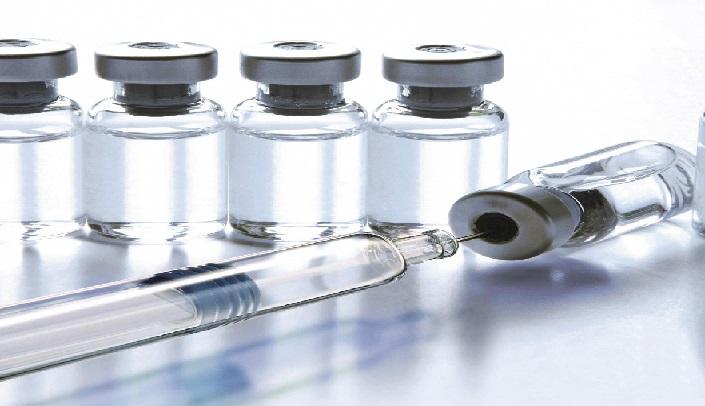Vaccine shows early promise against aggressive breast cancer

A small trial of an experimental vaccine has shown promising results for patients with the most aggressive type of breast cancer, according to a report published on Thursday in Genome Medicine.
Eighteen patients newly diagnosed with triple-negative breast cancer that had not yet spread to other organs received three doses of the personalized vaccine after undergoing standard chemotherapy and surgery to remove the tumor.
Three years later, 16 patients remained cancer-free. The study did not include a control group, but the researchers note that with standard care alone, about half of the patients would be expected to be cancer-free at three years.
The vaccine is designed to target key gene mutations in the patient's tumor called neoantigens, new proteins that have formed in cancer cells due to mutations in the tumor DNA.
The vaccines are also designed to train patients’ immune cells to recognize and attack any cells bearing these mutations.
As reported in a separate paper in the same journal, the researchers created software to identify the neoantigens most likely to trigger a strong immune response.
Small, early studies like this are designed to test safety, not effectiveness. Still, the results “were better than we expected,” Dr. William Gillanders of Washington University School of Medicine in St. Louis, who headed the trial, said in a statement.
“We are continuing to pursue this vaccine strategy and have ongoing randomized controlled trials that do make a direct comparison between the standard of care plus a vaccine, versus standard of care alone. We are encouraged by what we’re seeing with these patients so far.”
New method for replacing large muscular dystrophy genes
In studies in mice, an experimental technology allowed delivery of large healthy genes to replace dysfunctional ones that cause debilitating muscular dystrophies, researchers reported on Thursday in Science.
In muscular dystrophies and certain other conditions, the responsible genes are extremely large. Current methods for introducing healthy genes to replace faulty ones can’t transfer such substantial loads of genetic material into the body.
Elevidys, a gene therapy from Sarepta Therapeutics SRPT.O approved in the United States last year for treating young children with Duchenne muscular dystrophy, delivers a shortened version of the normal gene.
The new technology surmounts this obstacle by delivering two halves of a gene separately. Once in a cell, both segments join together.
RNA molecules called ribozymes act as the scissors, snipping the gene in half, the researchers explain.
When the ribozymes cut the RNA, they leave ends that are recognized by the cell’s natural repair pathway, which is then able to join the pieces back together.
The researchers have dubbed the process “StitchR” – short for stitch RNA. The stitched genes appear to behave essentially the same way as their natural full-length counterparts, effectively translating genetic information into functional proteins, according to the researchers.
In mice with muscular dystrophy, the treatment restored large therapeutic muscle proteins to normal levels, the researchers reported.
Specifically, StitchR restored the protein Dystrophin, which is absent in patients with Duchenne muscular dystrophy, and the protein Dysferlin, which is lacking in individuals with a less common form of the disease known as limb girdle muscular dystrophy type 2B/R2.
There are more than 30 types of muscular dystrophies, all of which weaken muscles. Patients often lose the ability to walk, and sometimes the disease affects heart and breathing muscles.
“With StitchR and other tools we are working towards treatments for some of the most debilitating genetic diseases on the planet, many of which have no current treatments or cures,” study leader Douglas Anderson of the University of Rochester School of Medicine and Dentistry said in a statement.
His team plans to work with other researchers to develop StitchR treatments for other diseases caused by large genes.
Nerve protection during stomach surgery yields benefits
Preserving an important nerve during surgery for early-stage stomach cancer yields better quality of life afterward, according to results of a clinical trial.
The trial involved 264 patients with early gastric cancer who were having surgery to remove the lower third of the stomach and reconnect the remaining portion to the small intestine.
In half of the patients, the surgeons did not cut through the vagus nerve, which carries signals between the brain and the digestive system. Electrophysiological methods and fluorescent dye were used to monitor the vagus nerve during the operation to insure it remained uninjured, surgeons reported.
Intraoperative neurophysiologic monitoring has been applied in thyroid and spinal surgeries for decades, but few studies have tested it for vagus nerve preservation, the researchers noted.
One year after the surgery, rates of stomach muscle impairment, or gastroparesis, in which the stomach empties itself too slowly, were 0.8% in the vagus nerve preservation group versus 7.6% in the usual surgery group.
Symptoms of gastroparesis can include bloating, nausea, vomiting and abdominal pain.
Gallstone formation, a common occurrence after this type of procedure, occurred in 6.8% of the usual-surgery group but not at all in the vagus nerve preservation group.
The preservation surgery took longer, but there were no differences in complication rates or in rates of cancer progression afterward, according to the report in JAMA Surgery.
A 2020 international analysis found gastric cancer to be the fifth most common cancer worldwide and the third leading cause of cancer-related mortality. — Reuters




